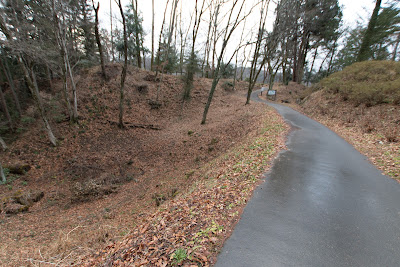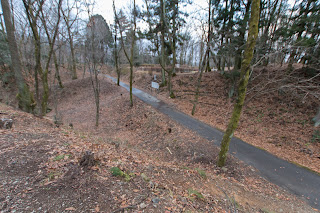Oshima Castle
-Man of culture lived at turbulent age-
Overview
Name: Oshima castle (Oshima-jo/Ohshima-jo)
Alias: Ina Oshima-jo, Dai-jo (Plateau castle)
Place: Moto-Oshima Matsukawa town, Nagano
Location: 35.576059840391416, 137.9169789341595
Type: Hill castle
Built: Originally in medieval era, expanded in 16th century
Remaining remnants: Clay walls and dry moats
Title:
Ina Oshima castle was originally built by local lord in medieval era. Shingen Takeda (1521-1573), a warlord of Kai provvince (Yamanashi prefecture), invaded to Ina valley and occupied in 1545. Shingen and his successor Katsuyori Takeda (1546-1582) expanded this castle as a major base of this area utilizing their castle building technologies.
Ina Oshima castle is built at the place where river terrace of Tenryu river directly projected to the river. This projection is about 300 meter long and 100 meter wide and spread from west to eastward, and castle utilizes this projection. As north, east and south side is guarded by cliff and river, this castle builds its three level defense line toward west.
Central area of this castle is an elliptical area of 80 meter long and 50 meter width locates at the highest point of the hill at east edge. Outside of inner dry moat of 20 meter width, about 50 meter long square secondary area exists. A small area of triangle shape is attached to the west of secondary area, and this might work as a front fort. It is said that this small triangle fort was later added by separating original secondary area or third area. to securely guard the entrance of secondary area.
Third area is the forefront area of 100 meter long and 50 meter width. Front side of this area is guarded by clay wall and 20 meter wide dry moat. Front gate of this castle equipped Umadashi fort, which is a 20 meter diameter semicircular area protected by crescent shaped dry moats. Umadashi area is built to support guarding soldiers to make counter attack or retreat, and characteristic to Takeda clan.
Especially this Umadashi area of Ina Oshima castle equips two layer dry moat, and is valuable to keep the original face even though inside is used as a house. There is another small fort at the north edge of the castle which located next to current path into the castle, and this was intended to make side attack to the enemy.
After the defeat at tbe battle of Nagashino against Oda clan in 1575, Katsuyori placed his uncle Nobukado Takeda (1532-1582) as a commander of this castle. Nobukado was a younger brother of Shingen, and good at culture such as painting. His paintings drawing his father or his mother still remain, and are nominated as Important Cultural Properties. He had a Buddhist name "Shoyo-ken", means wandering people of elegant, reflecting his desire.
Nobukado also resembled to his brother Shingen, and sometimes served as double of Shingen. When Shingen died in 1573 he ordered to conceal his death, thus Nobukado received a messenger from Hojyo clan pretending as Shingen.
If he lived in peace time, he could devote himself to art and might win a reputation, but this turbulent era and his position didn’t allow him such life. As a highest relative of Takeda clan he had work as a commander, but he was not good at military affairs. Nobukado mainly defend backward castles, but at the battle of Nagashino in 1575, he was the first to leave the battlefield and later blamed for this action.
In 1582, Kiso clan which guarded Kiso valley left Takeda clan and open the way to Takeda territory for Oda clan. Utilizing this opportunity, Oda clan started total assault to Takeda territory. Facing 50,000 soldiers of Oda army lead by Nobutada Oda (1557-1582), Masanao Hoshina (1542-1601), the commander of Iida castle, opened his castle and escaped.
Having only hundreds of soldiers, Nobukado also judged it was not possible to defend this castle, and retreated to the capital Kofu city wituout fight. But Takato castle which only resisted against Oda army fell in one day, and Oda army rushed into Kofu city within a week. Katsuyori killed himself at the foot of Mount Tenmokusan east of Kofu city, and Nobukado was also captured and executed by Oda army.
After the extinction of Takeda clan the castle was abandoned, and now used as a park named Daijyo Koen. Even though partially destructed, it is valuable as major base of Takeda clan mostly keep the original style. Now many azaleas are planted at castle site, and in May the site of the castle is covered by numerous flowers.
20 minutes walk from JR Central Iida-sen line Yamabuki station. 15 minutes drive from Chuo-Jidoshado Expressway Matsukawa interchange.
Takato Castle -Final glory of Takeda clan-
Iida Castle -Castle connected four provinces-
Type: Hill castle
Built: Originally in medieval era, expanded in 16th century
Remaining remnants: Clay walls and dry moats
Title:
Brief History
Ina Oshima castle (伊那大島城) is located on the hill facing Tenryu River, at Matsukawa town of Nagano prefecture. This castle placed at the middle of Iida castle (Iida city) at the southern tip of Shinano country (Nagano prefecture) and Takato Castle (Takato town), a major base of Takeda clan in this area, and important defense point of Ina valley.Origin and structure of Ina Oshima castle
Ina Oshima castle was originally built by local lord in medieval era. Shingen Takeda (1521-1573), a warlord of Kai provvince (Yamanashi prefecture), invaded to Ina valley and occupied in 1545. Shingen and his successor Katsuyori Takeda (1546-1582) expanded this castle as a major base of this area utilizing their castle building technologies.
Ina Oshima castle is built at the place where river terrace of Tenryu river directly projected to the river. This projection is about 300 meter long and 100 meter wide and spread from west to eastward, and castle utilizes this projection. As north, east and south side is guarded by cliff and river, this castle builds its three level defense line toward west.
Central area of this castle is an elliptical area of 80 meter long and 50 meter width locates at the highest point of the hill at east edge. Outside of inner dry moat of 20 meter width, about 50 meter long square secondary area exists. A small area of triangle shape is attached to the west of secondary area, and this might work as a front fort. It is said that this small triangle fort was later added by separating original secondary area or third area. to securely guard the entrance of secondary area.
Third area is the forefront area of 100 meter long and 50 meter width. Front side of this area is guarded by clay wall and 20 meter wide dry moat. Front gate of this castle equipped Umadashi fort, which is a 20 meter diameter semicircular area protected by crescent shaped dry moats. Umadashi area is built to support guarding soldiers to make counter attack or retreat, and characteristic to Takeda clan.
Especially this Umadashi area of Ina Oshima castle equips two layer dry moat, and is valuable to keep the original face even though inside is used as a house. There is another small fort at the north edge of the castle which located next to current path into the castle, and this was intended to make side attack to the enemy.
Man of culture lived at turbulent age
After the defeat at tbe battle of Nagashino against Oda clan in 1575, Katsuyori placed his uncle Nobukado Takeda (1532-1582) as a commander of this castle. Nobukado was a younger brother of Shingen, and good at culture such as painting. His paintings drawing his father or his mother still remain, and are nominated as Important Cultural Properties. He had a Buddhist name "Shoyo-ken", means wandering people of elegant, reflecting his desire.
Nobukado also resembled to his brother Shingen, and sometimes served as double of Shingen. When Shingen died in 1573 he ordered to conceal his death, thus Nobukado received a messenger from Hojyo clan pretending as Shingen.
If he lived in peace time, he could devote himself to art and might win a reputation, but this turbulent era and his position didn’t allow him such life. As a highest relative of Takeda clan he had work as a commander, but he was not good at military affairs. Nobukado mainly defend backward castles, but at the battle of Nagashino in 1575, he was the first to leave the battlefield and later blamed for this action.
End of castle and commander
In 1582, Kiso clan which guarded Kiso valley left Takeda clan and open the way to Takeda territory for Oda clan. Utilizing this opportunity, Oda clan started total assault to Takeda territory. Facing 50,000 soldiers of Oda army lead by Nobutada Oda (1557-1582), Masanao Hoshina (1542-1601), the commander of Iida castle, opened his castle and escaped.
Having only hundreds of soldiers, Nobukado also judged it was not possible to defend this castle, and retreated to the capital Kofu city wituout fight. But Takato castle which only resisted against Oda army fell in one day, and Oda army rushed into Kofu city within a week. Katsuyori killed himself at the foot of Mount Tenmokusan east of Kofu city, and Nobukado was also captured and executed by Oda army.
After the extinction of Takeda clan the castle was abandoned, and now used as a park named Daijyo Koen. Even though partially destructed, it is valuable as major base of Takeda clan mostly keep the original style. Now many azaleas are planted at castle site, and in May the site of the castle is covered by numerous flowers.
Access
20 minutes walk from JR Central Iida-sen line Yamabuki station. 15 minutes drive from Chuo-Jidoshado Expressway Matsukawa interchange.
Related Castles
Takato Castle -Final glory of Takeda clan-
Iida Castle -Castle connected four provinces-



































































































































































































































No comments:
Post a Comment